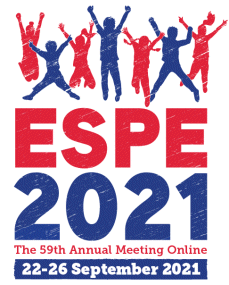
59th Annual ESPE (ESPE 2021 Online)
Online,
22 Sep 2021 - 26 Sep 2021

ePoster Category 2
Pituitary, neuroendocrinology and puberty
hrp0094p2-346 | Pituitary, neuroendocrinology and puberty | ESPE2021
The clinical and biochemical spectrum of pituitary lesions in children compared to adults: experience from a single tertiary center
Galazzi Elena , Carrara Silvia , Soranna Davide , Zambon Antonella , Maria Fatti Letizia , Moro Mirella , Persani Luca ,
hrp0094p2-347 | Pituitary, neuroendocrinology and puberty | ESPE2021
Optic tract glioma and endocrine disorders- comparison between patients with and without NF1- a single center experience
Gil Margolis Merav , Yackobovitz-Gavan Michal , Toledano Hellen , Phillip Moshe , Shalitin Shlomit ,
hrp0094p2-348 | Pituitary, neuroendocrinology and puberty | ESPE2021
Endocrine manifestations of paediatric intracranial germ cell tumour: from diagnosis to long-term follow-up
Partenope Cristina , Pozzobon Gabriella , Carceller Fernando , Albanese Assunta ,
hrp0094p2-349 | Pituitary, neuroendocrinology and puberty | ESPE2021
Machine learning to detect the Klinefelter syndrome endocrine profile
Madsen Andre , Aksglaede Lise , Juul Anders ,
hrp0094p2-350 | Pituitary, neuroendocrinology and puberty | ESPE2021
Nuchal Skinfold Thickness in Pediatric Brain Tumor Patients
Peng Junxiang , Boekhoff Svenja , Eveslage Maria , Bison Brigitte , Sowithayasakul Panjarat , Muller Hermann L. ,
hrp0094p2-351 | Pituitary, neuroendocrinology and puberty | ESPE2021
Growth hormone deficiency in 52 children with brain Magnetic Resonance Imaging Abnormalities
Baz Ouidad , Lydia Chelghoum Imane , Kafi Imane , Kafi Salima , Mimouni Safia ,
hrp0094p2-352 | Pituitary, neuroendocrinology and puberty | ESPE2021
Patients with PWS and related syndromes display differentially methylated regions involved in neurodevelopmental and nutritional trajectory.
Salles Juliette , Franchitto Nicolas , Bieth Eric , Eddiry Sanaa , Molinas Catherine , Salles Jean Pierre , Tauber Maithe ,
hrp0094p2-353 | Pituitary, neuroendocrinology and puberty | ESPE2021
Clinical course of primary empty sella in children: a 10-year single-center experience
Besci Ozge , Yasar Elif , Mert Erbas Ibrahim , Yuksek Acinikli Kubra , Demir Korcan , Bober Ece , Abacı Ayhan ,
hrp0094p2-354 | Pituitary, neuroendocrinology and puberty | ESPE2021
Relation between specific pubertal growth and breast maturation - a longitudinal study in healthy girls
Bergendahl Sophie , Niklasson Aimon , Stefan Aronson A. , Nierop Andreas F.M , Albertsson-Wikland Kerstin , Holmgren Anton ,
hrp0094p2-355 | Pituitary, neuroendocrinology and puberty | ESPE2021
Did Central Precocious Puberty Increase in COVID 19 Pandemic?
Orman Burce , Esen Senem , Keskin Meliksah , Sahin Nursel Muratoglu , Savas Erdeve Senay , Cetinkaya Semra ,
hrp0094p2-356 | Pituitary, neuroendocrinology and puberty | ESPE2021
Delayed diagnosis of paediatric intracranial germ cell tumour (IC-GCTs)
Partenope Cristina , Pozzobon Gabriella , Carceller Fernando , Albanese Assunta ,
hrp0094p2-357 | Pituitary, neuroendocrinology and puberty | ESPE2021
Gonadotropin-releasing hormone analog treatment in children with idiopathic central precocious puberty: a pharmacovigilance study in a pediatric population.
Nasso Chiara , Cafarella Giulia , Visalli Giulia , Di Prima Elena , Squadrito Violetta , Squadrito Francesco , Altavilla Domenica , Aversa Tommaso , Wasniewska Malgorzata , Valenzise Mariella ,
hrp0094p2-358 | Pituitary, neuroendocrinology and puberty | ESPE2021
Pubertal induction in girls with hypogonadism: preliminary prospective data of efficacy in patients with/without initial overnight estrogen replacement
Rodari Giulia , Federici Silvia , Persani Luca , Arosio Maura , Bonomi Marco , Giavoli Claudia ,
hrp0094p2-359 | Pituitary, neuroendocrinology and puberty | ESPE2021
Evaluation of pituitary/cranial imaging results of central-puberty precocious cases
Nur Peltek Kendirci Havva , Kaba İlknur , Fidan Nurdan Fidan ,
hrp0094p2-360 | Pituitary, neuroendocrinology and puberty | ESPE2021
In vivo magnetic resonance spectroscopy as a non-invasive tool for the identification of a sellar tumour in a boy with precocious puberty.
Kosteria Ioanna , M. Gavra Maria , Vlachopapadopoulou Elpis-Athina , A. Verganelakis Dimitrios , Dikaiakou Eirini , Vartzelis Georgios , Michalakos Stefanos ,
hrp0094p2-361 | Pituitary, neuroendocrinology and puberty | ESPE2021
Rahman Syndrome: Hypopituitarism might be responsible for changing height pattern
Betul Kaygusuz Sare , Turan Serap , Esen Nisa , Bereket Abdullah , Yesilyurt Ahmet , Guran Tulay ,
hrp0094p2-362 | Pituitary, neuroendocrinology and puberty | ESPE2021
Congenital hypopituitarism: the role of genetics
Gil Poch Estela , Javier Arroyo Diez Francisco , Mendez Perez Pilar , Galan Gomez Enrique ,
hrp0094p2-363 | Pituitary, neuroendocrinology and puberty | ESPE2021
Pedigree analysis is essential for clarifying oligogenic transmission in a family with congenital hypogonadotropic hypogonadism (CHH)
Oberhauser Sarah , Papadakis G Georgios , Pitteloud Nelly , L’Allemand Dagmar ,
hrp0094p2-364 | Pituitary, neuroendocrinology and puberty | ESPE2021
Congenital hypogonadotropic hypogonadism associated with X-linked ichthyosis due to X-chromosome microdeletion identified by chromosomal microarray
Kokoreva Kristina , Chugunov Igor , Kalinchenko Natalia , Latyshev Oleg , Samsonova Lyubov , Bezlepkina Olga ,
hrp0094p2-365 | Pituitary, neuroendocrinology and puberty | ESPE2021
Gonadotropin Flare with Different Depot GnRH Agonists: Comparative Analysis.
Freire Analia , Arcari Andrea , Gabriela Ballerini Maria , Ignacio Bergada , Gabriela Ropelato Maria , Gryngarten Mirta ,
hrp0094p2-366 | Pituitary, neuroendocrinology and puberty | ESPE2021
Hypothalamic obesity in children with craniopharyngioma
Baz Ouidad , Achir Samia , Tazibt Oulebsir , Mimouni Safia ,
hrp0094p2-367 | Pituitary, neuroendocrinology and puberty | ESPE2021
Duplication of Pituitary Gland-plus Syndrome presenting with a Transcranial Nasal Dermoid Cyst
Chandwani Manju , Spilioti Diamantina-Xanthi , Chumas Paul , Symth Alistair , Alvi Sabah , Nix Paul , Warren Daniel , Liddington Mark , Russell John , Elliott Mark ,
hrp0094p2-368 | Pituitary, neuroendocrinology and puberty | ESPE2021
Sterile Abscess Formation with Two Different GnRH Analogues: Three Case Reports
Karacan Kucukali Gulin , Ozalkak Şervan , Nur Peltek Kendirci Havva , Bostancı İlknur , Savas Erdeve Senay , Cetinkaya Semra ,
hrp0094p2-369 | Pituitary, neuroendocrinology and puberty | ESPE2021
6-Month GnRHa Formulations Are a Good Choice During the COVID-19 Pandemic and Beyond
R. Benson Matthew , N. Atkinson Stuart , M. Boldt-Houle Deborah , Miller Bradley S. ,
hrp0094p2-370 | Pituitary, neuroendocrinology and puberty | ESPE2021
Size Matters: CAG Repeat Length of the Androgen Receptor Gene, Testosterone, and Male Adolescent Depression Severity
Hirtz Raphael , Libuda Lars , Hinney Anke , Focker Manuel , Buhlmeier Judith , Antel Jochen , Holterhus Paul-Martin , Kulle Alexandra , Kiewert Cordula , Hebebrand Johannes , Grasemann Corinna ,
hrp0094p2-371 | Pituitary, neuroendocrinology and puberty | ESPE2021
Is quail egg a potential endocrine disruptor?
Surekli Karakus Ozlem , Arabaci Tamer Sevil , Nisva Levent Hilal , Betul Kaygusuz Sare , Turan Serap , Akakin Dilek , Guran Tulay , Caglayan Yegen Berrak , Bereket Abdullah ,
hrp0094p2-372 | Pituitary, neuroendocrinology and puberty | ESPE2021
The impact of the Covid-19 pandemic on the UK National Hypothalamic-pituitary Axis Tumour (HPAT) multidisciplinary meeting
Bosch i Ara Laura , Spoudeas Helen , Wei Gan Hoong ,
hrp0094p2-373 | Pituitary, neuroendocrinology and puberty | ESPE2021
Evaluation of Clinical, Laboratory and Radiological Findings in the Differential Diagnosis of Premature Telarche and Central Puberty Precocious
Nur Peltek Kendirci Havva , Kaba İlknur ,
hrp0094p2-374 | Pituitary, neuroendocrinology and puberty | ESPE2021
Crooke Cell Adenoma as a Rare Cause of Recurrent Cushing Disease: A Challenge in Treatment and Follow-up
Jalilova Arzu , Ozen Samim , Callı Cem , Ozgiray Erkin , Ertan Yeşim , Gokşen Damla , Darcan Şukran ,
hrp0094p2-375 | Pituitary, neuroendocrinology and puberty | ESPE2021
Salivary sex steroids as markers of puberty in boys during late childhood and adolescence
Patjamontri Supitcha , Spiers Alexander , Smith Rachel B , Shen Chen , Adaway Jo , G Keevil Brian , Toledano Mireille B , Ahmed S Faisal ,
hrp0094p2-376 | Pituitary, neuroendocrinology and puberty | ESPE2021
Efficacy of cabergoline in the treatment of pituitary macroadenoma complicated in a 14-year-old girl.
Jamal Anouar , Benyakhlef Salma , Aymane Loukili Mohamed , Rbiai Najoua , Rouf Siham , Latrech Hanane ,
hrp0094p2-377 | Pituitary, neuroendocrinology and puberty | ESPE2021
Use of Tolvaptan in a child with SIADH post pituitary surgery
Lohiya Nikhil , Didi Mohamed , Senniappan Senthil ,
hrp0094p2-378 | Pituitary, neuroendocrinology and puberty | ESPE2021
The effect of 3 years of Gonadotropin-Suppressive Therapy in Girls with Early Puberty: Height Z Score in Relation to Mid-Parental height Z score.
Alaaraj Nada , Soliman Ashraf , Hamed Noor , Ahmed Shayma , Alyafei Fawzia ,
hrp0094p2-379 | Pituitary, neuroendocrinology and puberty | ESPE2021
An Observational, Retrospective Study to Evaluate Long Term Safety and Effectiveness of Leuprorelin in the Treatment of Central Precocious Puberty
Fu Junfen , Dong Guanping , Li Pin , Gong Yan , Yang Yu , Yang Li , Gu Wei , Yuan Xuewen , Luo Xiaoping , Hou Ling , Zhong Yan , You Cheng , Wang Winston , Guo Ziheng ,
hrp0094p2-381 | Pituitary, neuroendocrinology and puberty | ESPE2021
Characterization of puberty development in a large cohort of patients with Noonan syndrome with molecular diagnosis
Rezende Raissa , Jorge Alexander , Noronha Renata , Keselman Ana , Andrade Nathalia , Dantas Naiara , Bertola Debora , Malaquias Alexsandra ,
hrp0094p2-382 | Pituitary, neuroendocrinology and puberty | ESPE2021
Pituitary tumors in children and adolescents: clinical and etiological profile
Bouichrat Nisrine , Messaoudi Najoua , Zerrouki Dounia , Rouf Siham , Latrech Hanane ,
hrp0094p2-383 | Pituitary, neuroendocrinology and puberty | ESPE2021
Langerhans Cell Histiocytosis with Isolated Central Diabetes Insipidus, Low Grade Fever and Sellar Erosion
OKUR Iclal , ARI Hasan , Cetinkaya Semra , Emine Derinkuyu Betul , Caglar Gizem , Gokce Cinar Hasibe , Yesil Sule , Savas-Erdeve Senay ,
hrp0094p2-384 | Pituitary, neuroendocrinology and puberty | ESPE2021
Basal LH as a screening test for diagnosis of central precocious puberty
Raafat Shaymaa , Abdelmeguid Yasmine , Fawzy Dina ,
hrp0094p2-385 | Pituitary, neuroendocrinology and puberty | ESPE2021
A Practical Method for the Evaluation of Childhood Hypophysitis: Pituitary Stalk/Basilary Artery Ratio
Torel Ergur Ayca , Şimşek Fatma , Arslan Kubra , Ali Yinanc Mehmet ,
hrp0094p2-386 | Pituitary, neuroendocrinology and puberty | ESPE2021
Blood Pressure in Girls with Central Precocious Puberty and GnRH Analog Therapy
Fisch Shvalb Naama , Harani Hadas Alfandary , Davidovits Miriam , Shvalb Nir , Demol Eliaz Sharon , Yackobovitch Gavan Michal , Phillip Moshe , de Vries Liat ,
hrp0094p2-387 | Pituitary, neuroendocrinology and puberty | ESPE2021
Isolated central diabetes insipidus and periventricular nodular heterotopia in a 9-year-old girl
Haufler Florentina , Walleczek Nina-Katharina , Vodopiutz Julia , Haeusler Gabriele , Raimann Adalbert ,
hrp0094p2-388 | Pituitary, neuroendocrinology and puberty | ESPE2021
Central precocious puberty: clinical, etiologic and therapeutic features
Assarrar Imane , Derkaoui Nada , Rami Imane , Rouf Siham , Latrech Hanane ,
hrp0094p2-389 | Pituitary, neuroendocrinology and puberty | ESPE2021
Atypical Presentation of Pituitary Macroadenoma in an adolescent girl: Central Hypothyroidism and Attenuated Pubertal Growth Spurt.
Alaaraj Nada , Soliman Ashraf , Hamed Noor , Ahmed Shayma ,
hrp0094p2-390 | Pituitary, neuroendocrinology and puberty | ESPE2021
A case of partially Empty Sella with hypopituitarism in a child
Pratap Rajat , Mason Leah , Basu Supriyo ,
hrp0094p2-391 | Pituitary, neuroendocrinology and puberty | ESPE2021
Cushing’s disease in paediatric patients: Diagnosis and evolution
Messaoudi Najoua , Assarrar Imane , Bouichrat Nisrine , Karrou Marouan , Rouf Siham , Latrech Hanane ,
hrp0094p2-392 | Pituitary, neuroendocrinology and puberty | ESPE2021
Late Puberty In Children
Asmae Touzani , Mohamed Boualam , Nouzha Rami , Yamna Kriouile , Zineb Imane , Abdellah Dami , Lhoucin Balouch , Ahmed Gaouzi ,
hrp0094p2-393 | Pituitary, neuroendocrinology and puberty | ESPE2021
First Morning Voided Urinary Gonadotropin Measurements for the Early Screening, Diagnosis and Follow-up of Central Precocious Puberty Patients
Ye Feng , Luo Xiaoping , Dong Guoqing , Chen Ruimin , Dong Zhiya , Lu Wenli , Fu Junfen , Zhan Shumin , Luo Feihong , Gong Chunxiu , Wei Liya , Yang Yu , Zhu Min , Ma Huamei , Chen Qiuli , Cheng Xinran , Gou Peng ,



